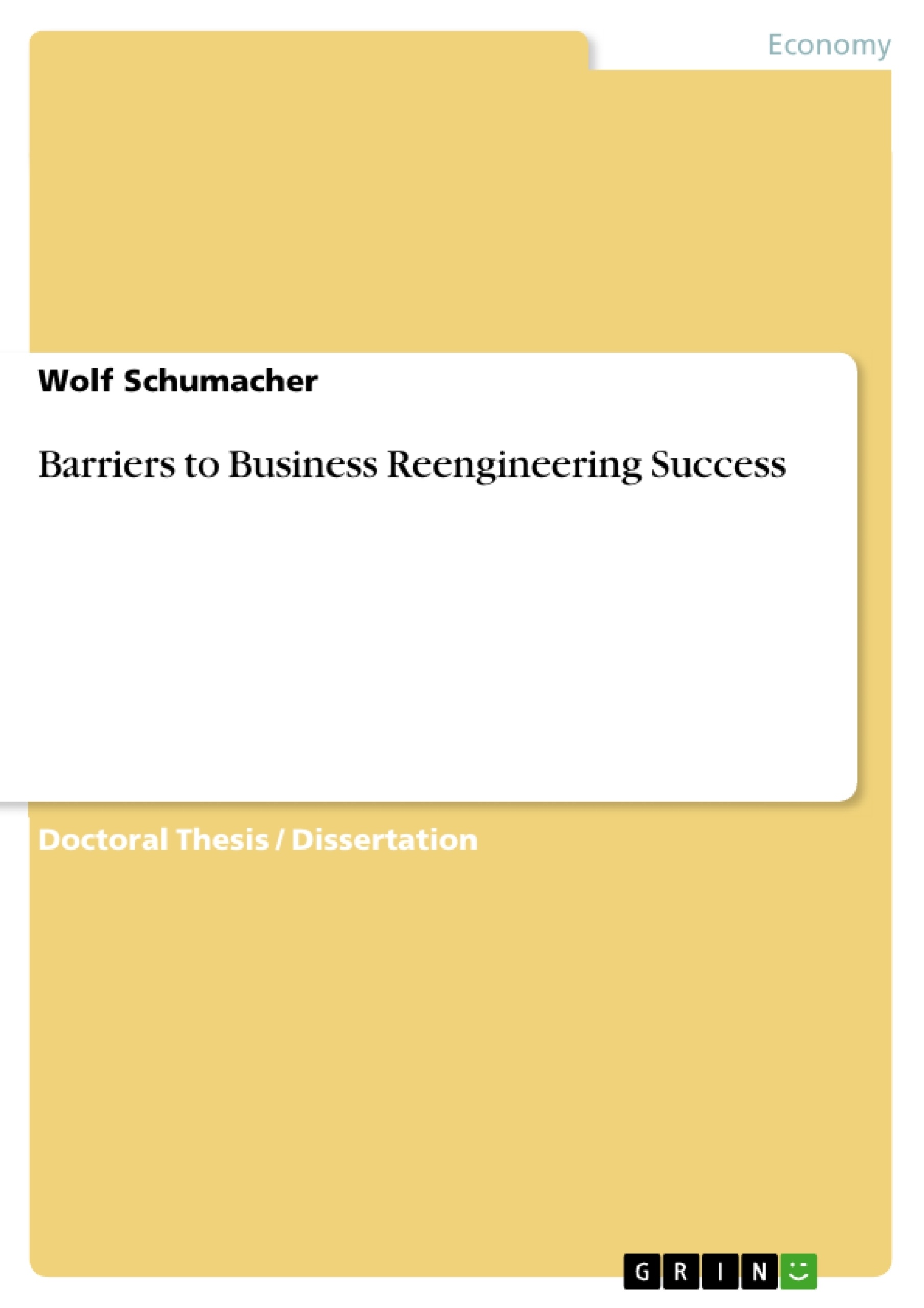Business Reengineering is on the agenda of many companies in different industries. Striving to improve business processes to better meet customer requirements, Business Reengineering initiatives also aim at revolutionizing key performance criteria, such as cost, delivery, and quality. Recently however it is being discussed whether Business Reengineering in reality is just another “management fad”, not having lived up to high expectations. Trade magazines and managers talk about failing Business Reengineering projects, consequently turning some companies away from Business Reengineering, towards other management initiatives which promise better bottom-line results. What goes wrong with Business Reengineering?
This practitioner’s report highlights that Business Reengineering is an important concept towards customer orientation, and concentrates on the obstacles to Business Reengineering project success. It defines hard and soft (people) barriers and traces these to their underlying causes.
The available vast literature on change management is consulted to identify intervention methods and techniques which help to treat causes of people barriers. A framework is presented which helps to manage barriers during the course of a Business Reengineering project. The framework is applied to a real project the author oversaw as a change agent. It turns out that organizational cultural aspects play a pivotal role in project success. Reviewing the implications of barriers to Business Reengineering success, this report proposes to turn away from a control-oriented culture towards a collaboration culture, which not only yields less resistance to change but also helps to focus all members of an organization towards its future. A short discussion of the instruments search conference and participative design concludes this report.
Table of Contents
- Chapter 1: Introduction
- 1.1. Objectives and Assumptions
- 1.2. Report Structure
- Chapter 2: Business Reengineering Projects
- 2.1. Definitions
- 2.2. The Development of Business Reengineering
- 2.3. The Principles of Business Reengineering
- 2.4. Business Reengineering Project Management
- 2.4.1. The Hammer/Champy Methodology
- 2.4.2. The Davenport Methodology
- 2.4.3. The Manganelli/Klein Methodology
- 2.4.4. The Kodak Methodology
- 2.5. Conclusion
- Chapter 3: Barriers to Business Reengineering Implementation Success
- 3.1. Potential Project Implementation Success
- 3.2. Risks Associated With Business Reengineering Projects
- 3.3. Business Reengineering Implementation Barriers
- 3.3.1. Hard Implementation Barriers
- 3.3.2. Soft Implementation Barriers
- 3.3.3. Relationships Between Hard and Soft Barriers
- 3.4. Areas Generating Barriers to Business Reengineering Implementation
- 3.4.1. Project Related Causes
- 3.4.2. People Related Causes
- 3.4.3. Organization Related Causes
- 3.4.4. Environment Related Causes
- 3.5. Examples for Root Causes to Implementation Barriers
- 3.5.1. Root Causes to Information Technology Barriers
- 3.5.2. Some Root Causes of Internal Individual Resistance
- 3.6. Conclusion
- Chapter 4: Change Management Intervention Models
- 4.1. Change Management Interventions
- 4.2. Change Management Literature Review
- 4.2.1. Psychology of the Individual Change Approaches
- 4.2.2. Social Psychological Change Approaches
- 4.2.3. Cultural Change Approaches
- 4.2.4. Innovation Approaches
- 4.2.5. Global Change Approaches
- 4.2.6. Practitioner Approaches to Change
- 4.3. Selected Intervention Models
- 4.3.1. Selected Individual Change Interventions
- 4.3.2. Selected Social Psychological Change Interventions
- 4.3.3. Selected Cultural Change Interventions
- 4.3.4. Selected Innovation Interventions
- 4.3.5. Selected Global Change Interventions
- 4.3.6. Selected Practitioner Interventions
- 4.4. Conclusion
- Chapter 5: A Framework for the Identification and Removal of Barriers to Business Reengineering Success
- 5.1. The Framework
Objectives and Key Themes
This report aims to provide practical insights into managing barriers to successful business reengineering projects. It explores the challenges and obstacles faced by companies implementing reengineering initiatives and suggests approaches for overcoming them.
- The complexities and challenges of implementing business reengineering projects
- The identification and analysis of barriers to successful reengineering implementation
- The role of change management in addressing people-related barriers
- The development of a framework for managing barriers during reengineering projects
- The importance of organizational culture in fostering a collaborative environment for successful change
Chapter Summaries
- Chapter 1: Introduction
This chapter sets the stage for the report, outlining its objectives and assumptions, as well as the structure of the subsequent chapters.
- Chapter 2: Business Reengineering Projects
This chapter provides a comprehensive overview of business reengineering, including its definition, historical development, key principles, and various project management methodologies.
- Chapter 3: Barriers to Business Reengineering Implementation Success
This chapter delves into the various barriers that can impede the successful implementation of business reengineering projects. It categorizes these barriers into hard and soft (people-related) categories and explores their underlying causes, which stem from project, people, organizational, and environmental factors.
- Chapter 4: Change Management Intervention Models
This chapter examines different change management intervention models that can be employed to address people-related barriers to reengineering. It reviews existing literature on individual change, social psychological change, cultural change, innovation, global change, and practitioner approaches to change.
- Chapter 5: A Framework for the Identification and Removal of Barriers to Business Reengineering Success
This chapter presents a practical framework for identifying and removing barriers to successful reengineering implementation. The framework serves as a guide for managers and change agents to proactively address potential obstacles throughout the project lifecycle.
Keywords
This report focuses on key topics such as business reengineering, change management, implementation barriers, organizational culture, intervention models, and project success. The report explores the challenges of organizational change and the importance of fostering a collaborative culture to overcome resistance and achieve desired business outcomes.
- Arbeit zitieren
- Wolf Schumacher (Autor:in), 1997, Barriers to Business Reengineering Success, München, GRIN Verlag, https://www.grin.com/document/417911



